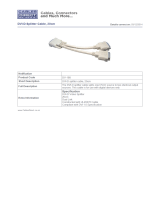User Manual English
Introduction
Thank you for purchasing the HDMI Cat.6 Splitter Extender. This product has been designed to provide
trouble free, reliable operation. It benefits from both a LINDY 2 year warranty and free lifetime technical
support. To ensure correct use, please read this manual carefully and retain it for future reference.
The HDMI Cat.6 Splitter Extender is a simple to use plug and play solution which lets you extend an
HDMI AV signal up to 50m* to 4 displays with each using a single low-cost Cat.6 UUTP cable (not
included). For added convenience IR signals (20-60 kHz) can also be extended using the supplied IR
Receiver and Emitter cables. Supporting resolutions up to Full HD 1080p, including 1080p 3D, the
Extender is designed for use in AV and digital signage applications in a variety of settings such as home,
education, business, retail and healthcare.
The Splitter Extender features an HDMI loop-through output on the Transmitter with simultaneous
viewing so that a local display can be connected for monitoring or to create an additional viewing zone.
For larger installations, the HDMI loop-through port can also be used to cascade up to 3 Transmitters
together, allowing up to 12 displays to be connected to a single source. To ensure the maximum
compatibility the Splitter Extender features a built in EDID emulation system which provides 9 EDID
presets as well as the ability to clone the EDID of a connected display via the HDMI loop-through port.
Power over Cat.6 (PoC) functionality enables the Extender to operate from a single power supply
connected to the Transmitter, allowing the Receivers to be located where there is limited access to
mains power sockets making it ideal for retro fit installations. In addition to PoC functionality the
Extenders slim design and integrated mounting brackets make it easier to install in limited spaces behind
modern flat screen displays.
*Please Note: The quoted lengths and resolutions are possible with a direct connection between
Transmitter and Receiver using good quality Cat.6 solid core cable. Using a different cable type, or
introducing wall plates, couplers or patch panels will result in a reduction of possible distances.
Package Contents
▪ 1 x HDMI Cat.6 Splitter Extender Transmitter
▪ 4 x HDMI Cat.6 Splitter Extender Receiver
▪ 1 x 12V DC2.5A Multi Country (Euro, US, UK & Australian/China)
▪ 2 x Mounting bracket with screws for the Transmitter
▪ 1 x IR Emitter with 3.5mm connector
▪ 4 x IR Receiver with 3.5mm connector
▪ LINDY Manual
Specification
▪ Extends HDMI & IR signals to 4 remote displays
▪ Connection via Cat.6 cable, up to 50m (Cat.6 solid core recommended)
▪ Local HDMI Output allows local & remote displays to be used simultaneously
▪ Supports daisy chaining up to 3 levels via the local HDMI output port
▪ Supports resolutions up to Full HD 1080p 60Hz (4:4:4 @ 8bpc, 4:2:2 @ 12bpc)
▪ Compliant with HDMI 1.3, HDCP 1.2 and DVI 1.0
▪ Supports Full HD 1080p24 3D
▪ Audio Formats: LPCM, DTS Digital, DTS HD, Dolby Digital & Dolby True HD
▪ PoC (Power over CAT6) feature requires only 1 x 12V 2.5A PSU to be attached









